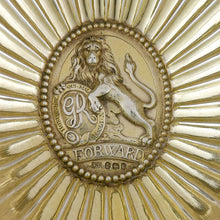London and Westminster Light Horse Volunteers Bowl, 1794 & 1875
Adding product to your cart
14.5cm (5.7in) x 5cm (2in) x 11.5cm (4.6in)
Silver. A bowl of oval form with gadrooned body, the base formed from a George III officer’s shoulder belt plate of the London and Westminster Light Horse Volunteer, with a rampant British lion holding a shield bearing the Garter motto and central ‘GR’ cypher, over a motto scroll inscribed ‘Forward’, the whole within a beaded border. Maker’s mark to the bowl of F.B. Thomas & Co., and hallmarked 1875. The shoulder belt plate bearing the maker’s mark of Francis Thurkle. Hallmarked London 1794.
Read more
The London and Westminster Light Horse Volunteer was raised in 1779 to counter the threat of French invasion and internal revolution. It was composed of wealthy gentlemen belonging to the merchant houses of the City of London, who in the season were in the habit of hunting together on the borders of Kent and Surrey. Each member of the corps was to equip himself at his own expense, which for a new recruit in 1795 amounted to £50 for a horse; £45.10s for keeping said horse; accoutrements and clothing, £31; diminution of value, £10; proportion of general expense, £10.10s. The high cost of the uniform was due to the fact there was hardly any difference between those of the officers and members as the Other Ranks were termed. Moreover it was a privilege of the regiment that the names of all persons enrolling themselves should be approved by the George III himself, and that they might be presented at Court in the uniform of the regiment. Another rule stated that every individual must join as a private and could only become an officer by election. Unlike the Yeomanry who received marching money when called out in support of the Government and local authorities, the L.V.H. turned out for free.

Aquatint by and after Thomas Rowlandson. From a volume of 86 aquatints entitled 'Loyal Volunteers of London and Environs', published by R Ackermann, 101 Strand, London, 1798-1799.








